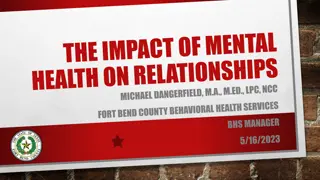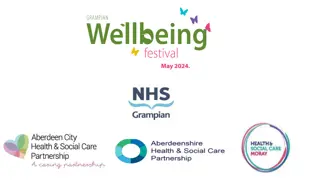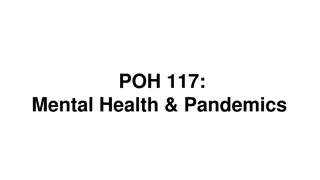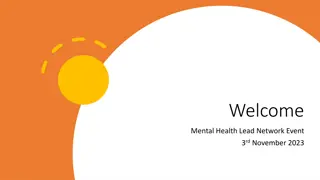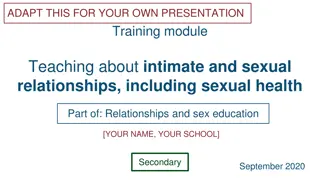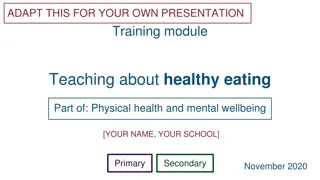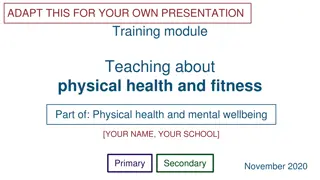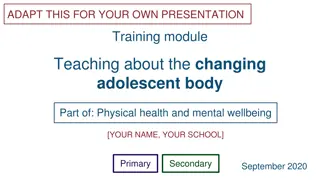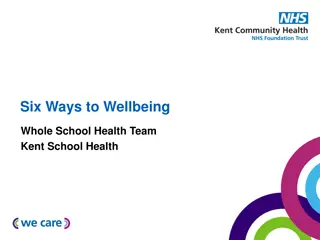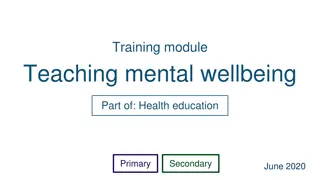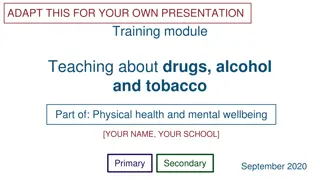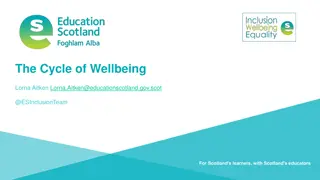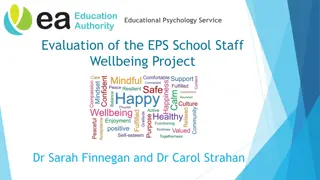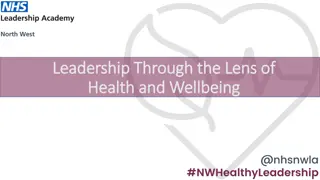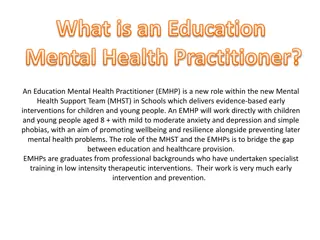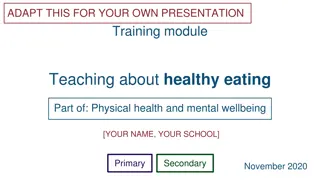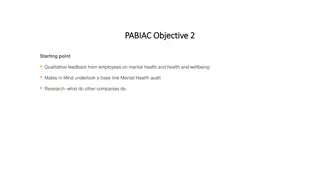Teaching Health and Prevention at [Your School]: Training Module for Physical Health and Mental Wellbeing
This training module provides a comprehensive guide for educators at [Your School] to teach about health and prevention, focusing on physical health and mental wellbeing. From understanding the curriculum to implementing strategies in the classroom, the module equips teachers with the knowledge and confidence needed to address these crucial topics effectively.
Download Presentation

Please find below an Image/Link to download the presentation.
The content on the website is provided AS IS for your information and personal use only. It may not be sold, licensed, or shared on other websites without obtaining consent from the author.If you encounter any issues during the download, it is possible that the publisher has removed the file from their server.
You are allowed to download the files provided on this website for personal or commercial use, subject to the condition that they are used lawfully. All files are the property of their respective owners.
The content on the website is provided AS IS for your information and personal use only. It may not be sold, licensed, or shared on other websites without obtaining consent from the author.
E N D
Presentation Transcript
ADAPT THIS FOR YOUR OWN PRESENTATION Training module Teaching about health and prevention Part of: Physical health and mental wellbeing [YOUR NAME, YOUR SCHOOL] Primary Secondary September 2020
Contents 3 About this training module 5 Teaching the new curriculum 12 Safeguarding 15 Ground rules 18 Primary curriculum 62 Secondary curriculum 95 Examples of good practice 99 Activities and templates for trainers 2
About this training module Subject leads can use the adaptable slides and activities and templates for trainers section at the end of this module to help shape training sessions for teachers. This non-statutory training module supplements the statutory guidance on teaching about health and prevention, which schools should read in full. Schools can choose whether and how to follow or adapt this training module and should refer to the Early Career Framework for pedagogical guidance. 3
What you get out of today By the end of this training you should: know what is included in the statutory guidance know some key knowledge and facts to cover as part of this topic have strategies to deal with questions that come up in class feel more confident teaching about health and prevention 4
Related topics Health and prevention is closely related to the science programmes of study as well as to the modules: physical health and fitness healthy eating mental wellbeing Therefore you should: consider thematic links across key topics and the whole school when planning and delivering lessons find ways to link knowledge and vocabulary across topics 6
Health and prevention support at [school name] Our leads [Names, contact details of school nurse or equivalent] Our policies [Add details - e.g. relevant school health policies] Specialist support [Add details - e.g. providers school already works with] Other information [Add resources] 7
Teaching about health and prevention at [school name] Ways in which we already teach about health and prevention at our school: [add details] [add details] [add details] 8
Primary and secondary teaching Some slides in this training have a Primary or Secondary label to indicate that the material is usually first introduced in that phase. STATUTORY GUIDANCE Schools have flexibility to design and plan age-appropriate subject content. (p31) Using your knowledge of your pupils and school community you can: introduce secondary content in primary with pupils who need it and are ready teach the primary content in early secondary lessons to pupils who need to build knowledge before secondary content is taught 9
Pupils with SEND You will need to plan lessons to allow all pupils to access and practise the core knowledge, using your expertise as you normally would. You might want to link lesson outcomes with statutory preparing for adulthood outcomes for those with an education, health and care (EHC) plan. (See SEND code of practice, section 8.) STATUTORY GUIDANCE In special schools and for some SEND pupils in mainstream schools there may be a need to tailor content and teaching to meet the specific needs of pupils at different developmental stages. As with all teaching for these subjects, schools should ensure that their teaching is sensitive, age-appropriate, developmentally appropriate and delivered with reference to the law. (p15) 10
Medical content The references to medical content within this module are intended as a teaching resource and are not an exhaustive list. Teachers are not expected to give medical advice or to be able to answer complex questions about medical conditions. If pupils have specific medical questions they should be directed to a medical practitioner. 11
Safeguarding 12
Safeguarding (1) Pupils may be affected by issues discussed in lessons. Let your designated safeguarding lead or deputy and any other relevant staff, such as pastoral leads, know what you are teaching. This will enable them to identify and speak to relevant pupils, especially those who they know may have been directly impacted by issues covered in the lessons and those with adverse childhood experiences. Teachers may need to deal with disclosures or concerns (e.g. of abuse or offending behaviour) in a way that safeguards pupils in line with school policies, especially the child protection policy. 13
Trusted adults Within this module we have used the term trusted adult. A trusted adult will generally be someone who children feel comfortable to turn to for help. Obvious examples include family members, teachers and doctors. It will be important when teaching this topic, and any other relevant topics, that teachers explore this concept. Pupils should be comfortable and capable of identifying who their trusted adults could be both within their families and wider circles. 14
Ground rules 15
Create class ground rules Clear class ground rules can help when teaching about sensitive topics. They also support confidentiality and safeguarding of pupils. Good practice is for ground rules to be: discussed and understood by all clear and practical modelled by the teacher followed consistently and enforced updated when needed visible in lessons (for example, posters) 16
Example ground rules Respect privacy. We can discuss examples but do not use names or descriptions that identify anyone, including ourselves. Listen to others. It is okay to disagree with each other, but we should listen properly before making assumptions or deciding how to respond. When disagreeing, challenge the statement not the person. No judgement. We can explore beliefs and misunderstandings about a topic without fear of being judged. Choose level of participation. Everyone has the right to choose not to answer a question or join discussion. We never put anyone on the spot (no personal questions or pressure to answer). 17
Common signs of illness (1) STATUTORY GUIDANCE Know how to recognise early signs of physical illness, such as weight loss, or unexplained changes to the body. Teach pupils that the majority of us are healthy most of the time. When we do get ill our bodies usually get better on their own, or with the help of medicine. The following are usually symptoms of a mild illness: skin rash (change in the colour or texture of the skin, such as red, scaly, bumpy or itchy skin) continuous cough and/or sore throat headache sticky eyes (conjunctivitis) sore ears or excess wax vomiting Primary 20
Common signs of illness (2) STATUTORY GUIDANCE Know how to recognise early signs of physical illness, such as weight loss, or unexplained changes to the body. diarrhoea high temperature or fever consistent cold, running nose pain when passing urine or needing to urinate more often Teach pupils that they should speak to a trusted adult if they have any of these symptoms, or any other health worries. Primary 21
Signs of more serious illness STATUTORY GUIDANCE Know how to recognise early signs of physical illness, such as weight loss, or unexplained changes to the body. Explain that sometimes, and much more rarely, we can have other symptoms which should be investigated by a doctor. For example: severe pain anywhere in the body, explained (e.g. from a fall) or otherwise loss of appetite an unexplained loss of weight hair loss Reiterate that there are many different common and often harmless causes for symptoms like these, and that it is better to speak to a doctor as a precaution. Primary 22
Sun safety 23
Sunlight and vitamin D STATUTORY GUIDANCE Know about safe and unsafe exposure to the sun, and how to reduce the risk of sun damage, including skin cancer. Teach that people s skin needs exposure to ultraviolet (UV) radiation in sunlight to produce vitamin D. Vitamin D helps the body absorb calcium and phosphate from our diet. These minerals are important for healthy bones, teeth and muscles. Explain that there is an important balance between getting enough sunlight to produce vitamin D and the risk of too much time in the sun and exposure to UV radiation which can be harmful. Primary 24
Unsafe exposure to the sun STATUTORY GUIDANCE Know about safe and unsafe exposure to the sun, and how to reduce the risk of sun damage, including skin cancer. The risks of too much exposure to the sun include: dehydration, when the body does not have as much water as it needs heat exhaustion, when the body overheats heatstroke, which is a severe form of heat exhaustion and a medical emergency sunburn, which is red, hot and painful skin caused by too much exposure to the sun - mild sunburn can be treated at home with an after sun cream or spray and usually gets better within 7 days severe sunburn, when the skin is blistered and swollen - this requires urgent medical attention Primary 25
UV radiation and our skin STATUTORY GUIDANCE Know about safe and unsafe exposure to the sun, and how to reduce the risk of sun damage, including skin cancer. Teach that too much UV radiation exposure can damage skin (and eyes). UV levels vary. The higher they are the greater the potential for damage, and the less time it takes for damage to occur. Explain that chilly days can have high UV levels. However, greatest care is generally needed: in spring when the weather gets warmer and skin is suddenly exposed to UV following a winter period going on holiday to very sunny climates where skin is exposed to much higher levels of UV Regularly spending time outdoors on milder days can help skin gradually build up a level of protection. Primary 26
Reducing the risks of the sun STATUTORY GUIDANCE Know about safe and unsafe exposure to the sun, and how to reduce the risk of sun damage, including skin cancer. Explain that we can reduce risk on sunny days if we: wear and regularly reapply sunscreen with an SPF* of 30 or higher on all exposed areas of the body wear a hat (ideally which covers the back of the neck and shades the face), cover shoulders spend time in the shade when the sun is strongest (11am to 3pm, March to October in the UK) wear sunglasses and do not look directly at sun stay hydrated by drinking plenty of water * Explain that the sun protection factor (SPF) indicates how long sunscreen should protect against some of the sun s UV radiation. Primary 27
Skin cancer STATUTORY GUIDANCE Know about safe and unsafe exposure to the sun, and how to reduce the risk of sun damage, including skin cancer. Teach that sun damage can increase the risk of skin cancer, a malignant tumour that grows in skin cells. Skin cancer is not common in children, but children can be affected by it. Risk can be increased by: exposure to the sun over a number of years (cancers usually occur in the areas of skin exposed to the sun) high levels of exposure to the sun (i.e. no protection), especially if the skin has received little exposure to the sun several cases of serious sunburn Primary 28
Sleep 29
Importance of good quality sleep STATUTORY GUIDANCE Know the importance of sufficient good quality sleep for good health and that a lack of sleep can affect weight, mood and ability to learn. Explain that sleep is important for many different reasons. For example, sleep: helps our brains consolidate information (remember and sort what we learn during the day) by strengthening the neural connections that form our memories enables the body to heal and grow as a growth hormone is produced at its greatest levels during deep sleep helps to regulate emotions as sleep affects the amygdala and the prefrontal cortex in the brain, both associated with the regulation of emotions Primary 30
How much sleep STATUTORY GUIDANCE Know the importance of sufficient good quality sleep for good health and that a lack of sleep can affect weight, mood and ability to learn. Teach that our bodies need the right amount of sleep which is usually determined by our age: 3 to 5 years: typically between 10 and 13 hours 6 to 12 years: typically between 9 and 12 hours Explain that a child getting up for school at 7am in the morning would need to be in bed and asleep by about 8pm the previous night to get this amount of sleep. Primary 31
How lack of sleep affects health STATUTORY GUIDANCE Know the importance of sufficient good quality sleep for good health and that a lack of sleep can affect weight, mood and ability to learn. Explain that a lack of sleep may: make us put on weight, as sleep affects hormone levels (ghrelin and leptin) in our bodies which control our appetite - lack of sleep can lead to us eating more and causing us to put on weight make it harder to learn and remember, as we find it more difficult to concentrate and remember things when we are tired put us in a bad mood, short tempered and more anxious, as people who are sleep deprived have increased negative moods, for example, anger, irritation and sadness Primary 32
Getting good quality sleep STATUTORY GUIDANCE Know the importance of sufficient good quality sleep for good health and that a lack of sleep can affect weight, mood and ability to learn. Good quality sleep can be achieved more easily by: having a routine of getting up and going to bed at the same time (including weekends) going to bed in time to get enough sleep having regular exercise to make the body tired going outside during the day, as daylight makes us feel alert during the day and tired at night limiting screen time in the evening turning off devices at least 2 hours before bed Primary 33
Importance of good dental health STATUTORY GUIDANCE Know about dental health and the benefits of good oral hygiene and dental flossing, including regular check-ups at the dentist. Teach that children have primary (baby) teeth which are replaced by permanent (adult) teeth. It is important to look after both sets of teeth equally. Explain that healthy adult teeth can last us a lifetime if they are looked after properly. If our teeth and gums are not looked after properly, we can develop diseases such as tooth decay and gum disease. Primary 35
Good dental hygiene (1) STATUTORY GUIDANCE Know about dental health and the benefits of good oral hygiene and dental flossing, including regular check-ups at the dentist. Teach that good dental hygiene involves: brushing twice a day (once before bed) for 2 minutes removing any plaque by brushing teeth gently even if the gums bleed using fluoride toothpaste, as fluoride strengthens the enamel to prevent tooth decay spitting and not rinsing after brushing, as fluoride helps protect teeth even after brushing Primary 36
Good dental hygiene (2) STATUTORY GUIDANCE Know about dental health and the benefits of good oral hygiene and dental flossing, including regular check-ups at the dentist. flossing or interdental cleaning to remove plaque between the teeth where the brush cannot reach (usually not necessary for primary school children and a dentist can advise whether it is required) Some food and drinks are very high in sugar which can affect the health of our teeth. Good dental hygiene must be combined with a limited intake of sugary food and drink as even the best dental hygiene cannot totally counter the bad effects of too much sugar. Primary 37
Benefits of dental checks STATUTORY GUIDANCE Know about dental health and the benefits of good oral hygiene and dental flossing, including regular check-ups at the dentist. Explain that having regular check ups with a dentist can prevent problems building up. Regular check-ups means that dentists can: spot any signs of tooth decay help repair teeth if there are any holes in them advise on ways to improve toothbrushing advise on how to reduce sugar consumption check that primary (baby) teeth are falling out when they should check that permanent teeth are growing and in good condition Primary 38
Personal hygiene (1) STATUTORY GUIDANCE Know about personal hygiene and germs including bacteria, viruses, how they are spread and treated, and the importance of handwashing. Teach the importance of good personal hygiene. Explain that good hygiene can help to prevent: illness, such as infections spreading germs skin problems Good hygiene is also important for social reasons, for example, to prevent body odour. Primary 40
Personal hygiene (2) STATUTORY GUIDANCE Know about personal hygiene and germs including bacteria, viruses, how they are spread and treated, and the importance of handwashing. Explain that good hygiene can be maintained by: washing the face daily regularly bathing or showering our body and hair cleaning ourselves and washing our hands after we use the toilet trimming fingernails and toenails to avoid trapping germs under them Primary 41
Germs and infections (1) STATUTORY GUIDANCE Know about personal hygiene and germs including bacteria, viruses, how they are spread and treated, and the importance of handwashing. Explain that germs are types of microbes (tiny living organisms) which can cause disease. They are so small they can only be seen through a microscope. Viruses, bacteria and fungi are all types of microbe. Explain that an infection is when germs get inside or on the surface of our bodies and start to multiply (grow) causing us harm. Infections can be: viral bacterial fungal Primary 42
Germs and infections (2) STATUTORY GUIDANCE Know about personal hygiene and germs including bacteria, viruses, how they are spread and treated, and the importance of handwashing. Viral infections are infections by a virus. Viruses are usually harmful to humans. Viruses cannot survive by themselves and need a host cell in order to survive and reproduce. Once inside the cell, they multiply and destroy the cell in the process. Viral infections include: the common cold flu virus stomach bugs which cause diarrhoea (e.g. rotavirus) Primary 43
Germs and infections (3) STATUTORY GUIDANCE Know about personal hygiene and germs including bacteria, viruses, how they are spread and treated, and the importance of handwashing. Bacterial infections, are infections by bacteria. Bacteria can be found everywhere, and can be harmful, such as when they cause food poisoning or infection, or beneficial to the body and improve health. Harmful bacteria include: clostridium difficile, which can cause diarrhoea staphylococcus aureus, which can cause skin infections, pneumonia and other serious infections Primary 44
Germs and infections (4) STATUTORY GUIDANCE Know about personal hygiene and germs including bacteria, viruses, how they are spread and treated, and the importance of handwashing. Fungal infections, are infections by fungi. Fungi are multicellular organisms. Fungi get their food by either decomposing dead organic matter or by living as parasites on a host. Fungi occur naturally on the body. An infection occurs when fungi take over an area of the body and overwhelm the immune system. Fungi which can cause infections include trichophyton, which can cause athlete s foot and ringworm. Primary 45
How germs spread STATUTORY GUIDANCE Know about personal hygiene and germs including bacteria, viruses, how they are spread and treated, and the importance of handwashing. Explain that people can become infected with harmful germs by: breathing them in through the air (e.g. when someone else has coughed or sneezed) touch (e.g. from one person to another) drinking or washing in dirty water rotten or contaminated food that bacteria or fungi have grown on contact with animals or their faeces hands that are not washed after going to the toilet sharing other people's forks, knifes or cups Primary 46
Handwashing (1) STATUTORY GUIDANCE Know about personal hygiene and germs including bacteria, viruses, how they are spread and treated, and the importance of handwashing. Explain that the hands naturally secrete oil which helps to keep the skin moist and stop it getting too dry. This oil is a good environment for microbes to grow and multiply and helps them stick to our skin. Washing our hands with soap and warm water removes this oil and the germs with it. Primary 47
Handwashing (2) STATUTORY GUIDANCE Know about personal hygiene and germs including bacteria, viruses, how they are spread and treated, and the importance of handwashing. Teach that the spread of germs can be reduced when hands are washed: before, during and after preparing food after using the toilet after exposure to animals or animal waste after coughing, sneezing or blowing the nose if they have been ill or have been around ill people Explain that if hands cannot be washed with soap and water, then using an alcoholic handwash (60% alcohol) can help protect from viruses and bacteria. Primary 48
Sneezing and coughing STATUTORY GUIDANCE Know about personal hygiene and germs including bacteria, viruses, how they are spread and treated, and the importance of handwashing. Explain that the most common way of spreading infection is through coughing and sneezing. To avoid spreading infection, teach that: covering the mouth and nose with a tissue when coughing or sneezing is important throwing used tissues in the bin washing hands with soap and water Where people cannot cough or sneeze into a tissue, they can cough or sneeze into the inside of their elbow. Primary 49
How infection is treated STATUTORY GUIDANCE Know about personal hygiene and germs including bacteria, viruses, how they are spread and treated, and the importance of handwashing. Teach that most harmful germs are stopped from entering or proliferating (growing) within the body by the immune system. Sometimes our immune system needs help to fight off germs and we need to take medicines such as: antibiotics antivirals antifungals More details on pharmaceutical interventions are given in the secondary guidance. Primary 50
![Teaching Health and Prevention at [Your School]: Training Module for Physical Health and Mental Wellbeing](https://cdn1.slideorbit.com/167013/adapt-this-for-your-own-presentation-training-n.jpg)



